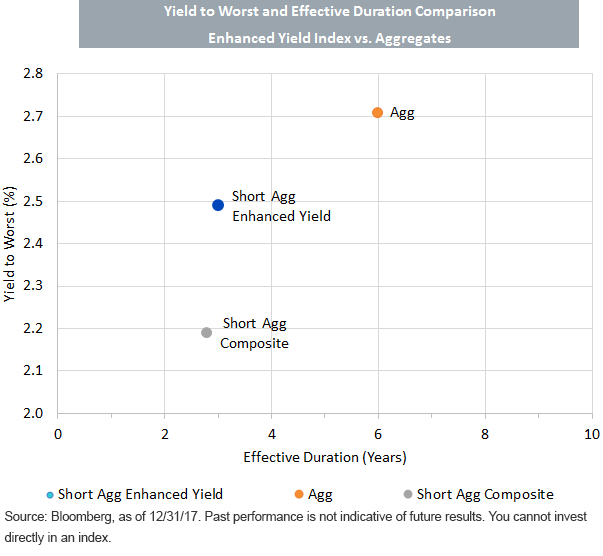How to Avoid Negative Fixed Income Returns in 2018


If fixed income strategists are right, investors’ core fixed income portfolios could generate zero total returns in 2018. With median forecasts1 calling for a rise in U.S. bond yields of approximately 50 basis points (bps), the resulting price loss of the Bloomberg Barclays U.S. Aggregate Index (Agg) would be approximately 3%. With yields on the Agg starting the year at 2.71%, price losses will more than fully offset income. In order to avoid the fate of the performance benchmark, we would advocate reducing interest rate risk, increasing credit risk or a combination of both.
Reducing Interest Rate Risk
The Federal Open Market Committee will likely hike interest rates three times in 2018. This need not necessarily lead to losses for bond holders, but any resurgence in inflation will. This logic stems from the fact that the Federal Reserve (Fed) can influence short-term interest rates, whereas the outlook for growth and inflation impact yields at the longer end of the curve. While much has been made about the implications of a flattening yield curve, one consequence is that investors receive only incrementally higher yields for extending maturity. Put another way, the implicit opportunity cost of reducing interest rate risk is diminished. In our view, one simple way for investors to potentially add value versus the Agg is to reduce interest rate risk by at least one year.
Accepting Credit Risk
Few can argue that U.S. investment-grade credit is “cheap,” but we recently highlighted a few positive catalysts that could result from U.S. tax reform. The primary reason why we would advocate increasing exposure to credit risk at the expense of Treasuries is that this approach increases income opportunities. If we accept that rates will likely rise and that economic growth can continue, then increasing exposure to credit can boost returns. In our view, while 90 bps2 over Treasuries is below historical averages, we see few reasons why credit spreads should meaningfully deteriorate in the medium term. As such, investors should accept the opportunities that the market is providing for the time being.
Combining Views into a Portfolio
While some investors may prefer to outsource decisions to an active manager, we believe a more intuitive approach to indexing can provide comparable benefits. When WisdomTree seeks to create a performance-driven Index, our goal is to incorporate investment intuition into the process. While performance benchmarks may provide reasonable approximations of the market, there is no guarantee that they will achieve the objectives of all investors. In the current environment, we would advocate reducing interest rate risk and increasing credit risk. Through our collaboration with Barclays, we helped create the Bloomberg Barclays U.S. Short Aggregate Enhanced Yield Index (Short Agg Enhanced Yield).
In this approach, we use the same investable universe as the Agg, but then we apply a series of constraints to meet our investment objectives.
Step 1: Limit eligible securities to between one and five years to maturity to limit interest rate risk.
Step 2: Divide the investable universe into 13 subcomponents across maturity, sector and credit quality.
Step 3: Maximize yield across each bucket while applying constraints to tracking error, duration, sector, credit quality and turnover
As the chart below shows, if investors seek only to reduce duration, it’s going to reduce yield by over 50 bps (proxied by the Short Agg Composite). However, by boosting exposure to credit risk, the enhanced-yield strategy was able to add back about 30 bps of income. In this approach, the trade-off became a 20 bps sacrifice in yield while cutting interest rate risk in half.

For definitions of terms in the chart, please visit our glossary.
While strategist forecasts may inevitably evolve over the course of 2018, we believe investors should consider a variety of ways to boost income while reducing interest rate risk. By combining these two market views into a single strategy, we believe the WisdomTree Barclays Yield Enhanced U.S. Short-Term Aggregate Bond Fund (SHAG) can serve as a powerful tool to efficiently bundle these exposures for investors.
1Source: Bloomberg, as of 1/16/18.
2As measured by the Bloomberg Barclays U.S. Credit Index, as of 12/31/17.
Important Risks Related to this Article
There are risks associated with investing, including possible loss of principal. Fixed income investments are subject to interest rate risk; their value normally will decline as interest rates rise. Fixed income investments are also subject to credit risk, the risk that the issuer of a bond will fail to pay interest and principal in a timely manner or that negative perceptions of the issuer’s ability to make such payments will cause the price of that bond to decline. Investing in mortgage- and asset-backed securities involves interest rate, credit, valuation, extension and liquidity risks and the risk that payments on the underlying assets are delayed, prepaid, subordinated or defaulted on. Due to the investment strategy of the Fund, it may make higher capital gain distributions than other ETFs. Please read the Fund’s prospectus for specific details regarding the Fund’s risk profile.
BLOOMBERG® is a trademark and service mark of Bloomberg Finance L.P. and its affiliates (collectively “Bloomberg”). BARCLAYS® is a trademark and service mark of Barclays Bank Plc (collectively with its affiliates, “Barclays”), used under license. Bloomberg or Bloomberg’s licensors, including Barclays, own all proprietary rights in the Bloomberg Barclays Indices. Neither Bloomberg nor Barclays is affiliated with WisdomTree, and neither approves, endorses, reviews or recommends SHAG. Neither Bloomberg nor Barclays guarantees the timeliness, accurateness or completeness of any data or information relating to the Bloomberg Barclays U.S. Short Aggregate Enhanced Yield Index, and neither shall be liable in any way to the WisdomTree, investors in SHAG or other third parties in respect of the use or accuracy of the Bloomberg Barclays U.S. Short Aggregate Enhanced Yield Index or any data included therein.


